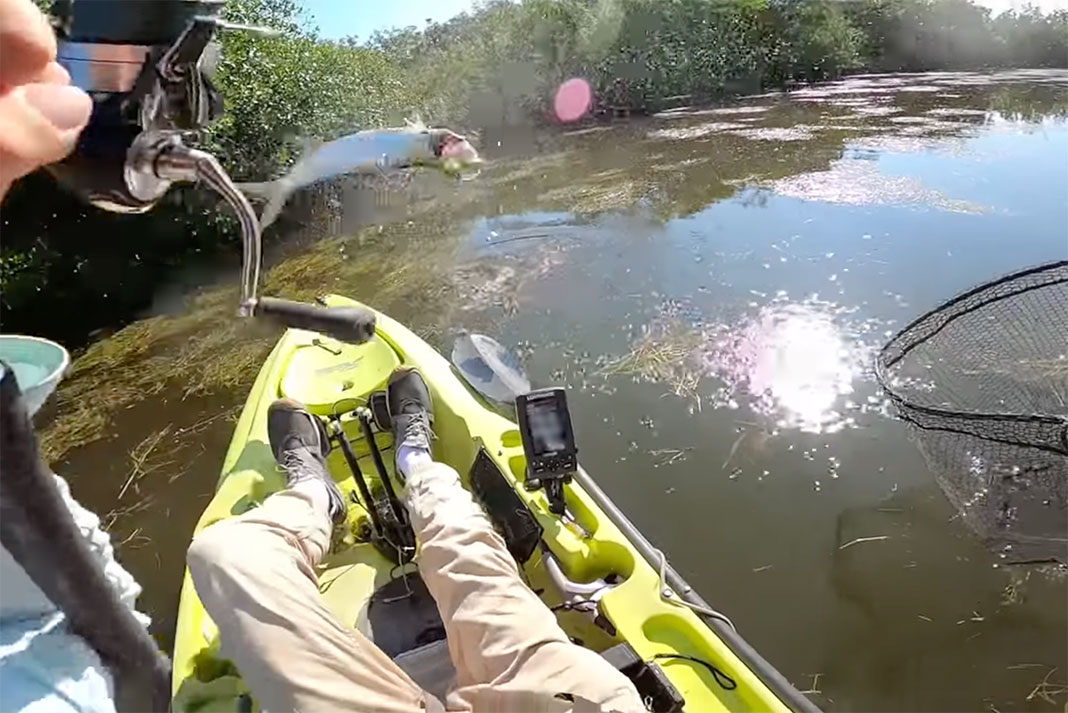Tarpon are one of the most revered gamefish on earth. They jump, run, dive and charge, pulling all the tricks out of the hat. These tricksters manage to spit the hook or break the line about 70 percent of the time. That’s if you’re even lucky enough to get a bite, since tarpon are famous for ignoring everything in the tackle box. The payoff is one of the most spectacular battles in fishing with one of the most impressive fish in the sea. Many anglers focus on big tarpon, up to 200 pounds, but our sharpies target juvenile ‘poons in the heat of summer. Whether you’re fishing Florida’s east coast or west coast, these tarpon guides have you covered.
East Versus West for Florida’s Best Tarpon Tactics
1 East Coast
Angler: Dee Kaminski, Native Watercraft pro guide, reelkayakfishing.com
Location: Mosquito, Banana and Indian River Lagoons
Find the Fish: Backwater creeks and residential canals around dock pilings or a creek mouth. On a calm day, the fish move out into the open, but when it gets windy they retreat to the back of the canal or under the dock. Look for tarpon rolling and gulping air.
Weather: Overcast, calm days. Early mornings and late afternoons are best.
Tactics: Cast into the docks or deadfall. Learn to read the roll. If the fish make a slow roll, cast in front of its back and keep the lure on the surface. If it makes a quick roll, land the lure four feet ahead and work through the middle of the water column. A tail splash means the fish is feeding deep, let the lure drop to the bottom.
Rod and Reel: Medium-heavy, seven-foot spinning rod, with a 3500 series reel with enough backbone and drag pressure to pull a tarpon out of the structure.
Line and Leader: 20-pound braid with three feet of 30-pound fluorocarbon.
Lures and Baits: Paddletails rigged weedless on a 1/16-ounce, 4/0 blood-red weedless hook. 1/16-ounce Buggs Bonefish lure. If you’re fishing bait, choose the biggest shrimp you can find and rig on a 2/0 circle hook.
Tips and Tricks: Bow to the silver king. When a tarpon leaps out of the water, point the rod tip at the fish, straighten your arms and slack the line to keep the hook from falling out.

2 West Coast
Angler: Eric Henson, Old Town pro, castingkayaks.com
Location: Sarasota, Florida
Find the Fish: Look for structure like deadfalls. When I snag on submerged tree limbs, I expect to get hooked up.
Weather and Water: Chocolate brown water. Both low oxygen and low visibility attract summer tarpon. Falling tide and low light are best. Be sure to fish a hot summer night right after a rain shower.
Tactics: Spot rolling tarpon and anchor the kayak just inside casting distance. The fish are easy to spook. Make a long cast and land the lure past the fish. Start with a slow retrieve then speed up the action. When I find the depth where fish are feeding, I repeat the same retrieve.
Rod and Reel: Seven-foot, medium-heavy spinning rod and a 4000-class reel.
Line and Leader: 20-pound braided line with 30-pound leader.
Lures and Bait: Monster 3X 2 1/4-inch Ultra Soft or -Move jig, Yo-Zuri lipped lures
Tips and Tricks: Land juvenile tarpon with a rubber-mesh net; a lip gripper will damage the tarpon’s mouth. Do not hold the fish vertically by the lip. Only keep the tarpon out of the water for a limited time.
Juvenile silver prince. | Feature photo: Eric Henson










I thought this was an article about FLORIDA MAN! 🙂